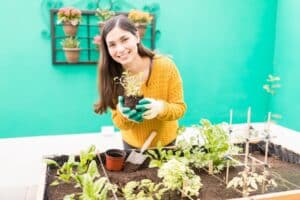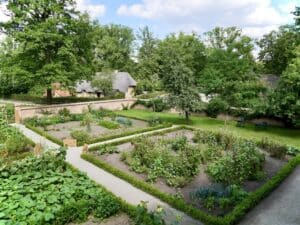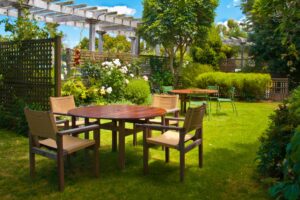Indoor Plants and Sunlight

Sunlight is an essential ingredient for every plant. Generally, indoor plants will experience sunlight in a slightly different way than outdoor plants. We’ve written before about How Much Sunlight Plants Need, but that guide was largely focused on outdoor gardens.
Given the booming popularity of indoor plants right now, we thought it was about time for a guide that focused a bit more on the leafy family that live inside your home. Here’s what you should know about indoor plants and sunlight.
Why do Indoor Plants need sunlight?
Just in case you need a refresher, plants need sunlight in order to photosynthesise. We talk about photosynthesis often on our gardening advice blog, and that’s because it’s the most important biological process in the world.
Photosynthesis is the process that plants use to convert sunlight and water into energy and nutrients for your plant to feed on and survive. This amazing process also allows plants to convert the carbon dioxide in the air into oxygen, making all of life on earth possible.
It’s just one more reason that we think everyone should love plants. They do so much for us! So if you ever find yourself wondering if plants really need sunlight, remember that all life on earth depends on it.
The difference between indoor and outdoor sunlight.
Most outdoor plants receive direct sunlight, unless they’re under the verandah and in the shade all the time. When you are indoors, all of the sunlight that your plants receive will be filtered light. This is light that has passed through your windows or glass doors and is bouncing around your home. It’s usually less intense than direct, outdoor sunlight.
This gentler sunlight means outdoor plants that enjoy a bit of both sun and shade will often make for great indoor plants. But it’s important to realise that there are still varying degrees of intensity for filtered light. This means there are plenty of different options available when you’re choosing an indoor plant for your home.
Different types of indoor sunlight
Filtered indoor light can still be classified as full sun, partially shaded or fully shaded (often called low-light). Which one your plant will experience depends on the direction the nearest window is facing, and the distance that you place your plant from the window.
You’ll find that all of the indoor plants in our store can be browsed according to these three categories – just check the appropriate box in the ‘exposure’ menu above the store while you browse.
It’s worth remembering that these categories aren’t clear-cut for every plant, and many plants will thrive in a variety of conditions. Yet they are still helpful to know about, so let’s get into these three categories in a bit more detail.
1. Full Sun
Full sunlight indoors is usually found right in front of north or westerly facing windows. These windows get several hours of hot afternoon sun every day. Anywhere in your home that routinely enjoys a pool of bright, warm sunlight is likely a full-sunlight spot.
These plants may also benefit from occasionally spending a few hours outdoors. However, even sun-loving plants will sometimes need some shade too. Sun-loving indoor plants include the Maidenhair Fern, Ficus Benjamina and Pilea Aluminium.
2. Partial Sun and Shade
Partial sun is less intense than full sun, and can usually be achieved by placing your plants near a south or easterly facing window. This will allow your plants to get a few hours of gentle morning sun and then lots of shade in the afternoon.
If the care instructions for your indoor plant simply say ‘filtered light’, there’s a good chance that this is what they mean. Many indoor plants love this type of partial sun, including Japanese Aralia, Monstera and Fiddle Leaf Fig (Ficus Lyrata). Hot afternoon sun may burn these plants, so be careful where you place them.
3. Full shade / Low Light.
This is just what it sounds like – the kind of indirect, heavily filtered light that’s far away from your window. Many plants like somewhere in between full shade and partial sun. However, a plant that strongly prefers low light is likely to burn and struggle to survive if you place it too close to a source of sunlight. Keep it somewhere cool and dark instead.
These types of plants have usually evolved to live under a dense tree canopy where there isn’t much light. They may still like some occasional morning sun, but much less than a partial-sun plant would need. Popular low-light plants include Pothos Devils Ivy, Philodendrons, and Zanzibar Gem.
4. How to tell if your indoor plant isn’t getting enough sun.
Because they spend so much of their lives inside, it’s common for indoor plants to not get enough sun. You’ll be able to tell that your plant isn’t getting enough sun if it appears to be struggling to grow. It’s a sign that photosynthesis is limited or not occurring properly.
No new leaf growth, yellowing leaves, long & thin stems and generally sparse growth are all signs that your plant is struggling with not getting enough light. One well-observed sign of your plant needing light is that it may begin to lean or curve towards the sun.
This fascinating lean is called a phototropic response and has even led some scientists to debate whether plants are making ‘conscious’ choices the way that humans do. In reality, these movements are controlled by a hormone in the plant called Auxin, which reacts automatically to sunlight and moves around the plant accordingly.
If your plant is telling you that it isn’t getting enough sun, try moving it into a brighter location or taking it outside at regular intervals until it recovers. Rotating your plant can also help it receive sunlight more evenly. If none of this helps, it could be that your plant is suffering from a different issue, like over or underwatering.
How to tell if your indoor plant is getting too much sun.
It’s also very possible for your indoor plant to receive too much light. This is especially relevant to low-light plants, which are not able to withstand much sunlight before beginning to struggle. Yet even full-sun plants may burn in the hot summer months, especially if they are never moved or rotated.
Indoor plants that are receiving too much sun will become dried out and can feel crunchy or crusty to the touch. Plants that have flowers or bright foliage will also start to look sun-bleached and lose some of their distinctive colour. Finally, wilting and drooping are also signs of a sun-battered plant.
If you think your plant is getting a little too much sun, try moving it into a more shaded position for a while. Rotating your plant is also essential, as it ensures that the sunlight is distributed evenly and not laser-focused on one side of the plant.
Can I use indoor grow lights as a substitute for sunlight?
Some gardeners like to use grow lights for indoor plants to supplement or replace sunlight. We’ve found that while these lights do work, they don’t quite compare to the real thing. Grow lights will also cost money to run, whilst energy from the sun is completely free.
However, these lights are still a viable option if you live in an apartment with poor window placement, or if you are trying to grow vegetables inside. The most popular and energy-efficient option for grow lighting is LED lights. You can also use fluorescent lighting or HID lights, but these are more expensive to run.
You will see these grow lights marketed with numbers like 2000K or 4000K. This indicates where on the colour spectrum they are, and if they are putting out cool or warm light. Foliage plants prefer warm light, whereas fruit and flowers will need a cooler light to flourish.
The higher the ‘K’ number, the cooler the light. If you are interested in grow lights, here and here are both good resources for learning more.
Sunlight is essential for all plants. It’s always important to check the specific care instructions for the plant that you’re bringing home to see exactly what kind of sunlight conditions it will need.
By following the tips and information set out in this guide, you’ll be on the road to growing a huge, healthy indoor garden in no time. Anyone can learn to be a natural green thumb with a little bit of time, love and care!
Check out the diverse range of beautiful indoor plants at Diacos today to get your indoor garden started.
-
 13, Jun, 2025
13, Jun, 2025How to Start a Garden Design Project: Step-by-Step Planning Guide for Beginners
At Diaco’s, we know that creating a beautiful garden starts... -
 27, May, 2025
27, May, 2025Smart Garden Layout Ideas: How to Maximise Your Outdoor Space
At Diaco’s, we believe every garden has potential. Whether you’ve... -
 9, May, 2025
9, May, 20257 Garden Design Principles to Transform Your Outdoor Space
At Diaco’s, we know that creating a garden isn’t just...


